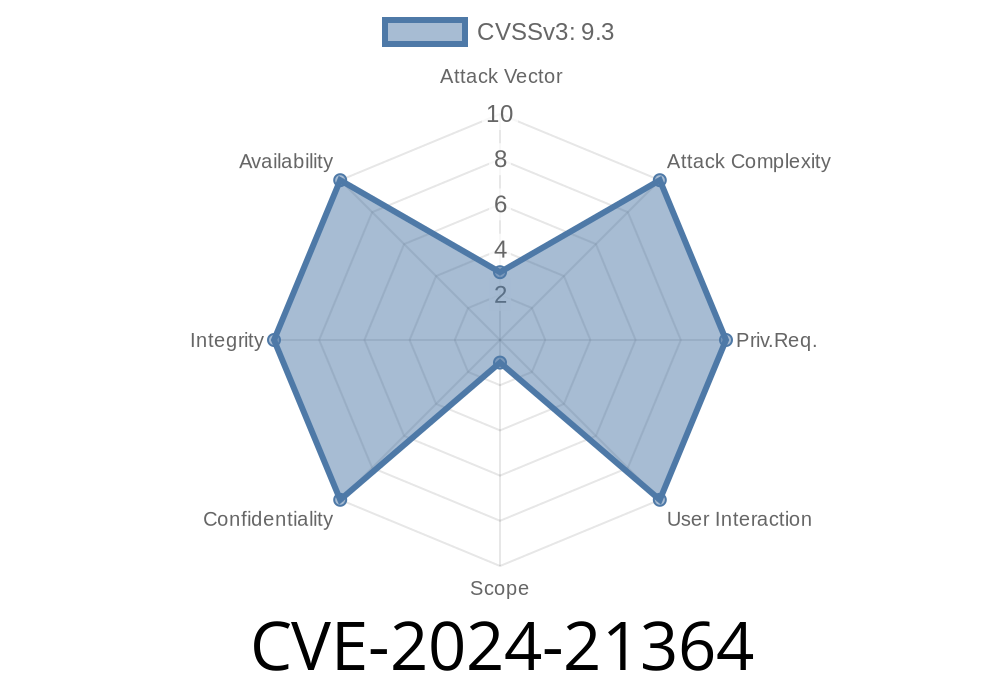Microsoft Azure Site Recovery (ASR) is a disaster recovery service that helps organizations to keep their critical applications running during system failures or other destabilizing events. This long-read post will delve into vulnerability dubbed CVE-2024-21364 – it allows for an elevation of privilege within the Azure Site Recovery service, putting your organization's data and applications at risk.
We will provide an analysis of the affected components, explore the potential impact of the exploit, review mitigation strategies and present code snippets to secure your Azure Site Recovery environment. Additionally, we will provide links to original references and additional resources to help you better understand this vulnerability and stay well-informed on related updates.
Vulnerability Overview
CVE-2024-21364 refers to an elevation of privilege vulnerability which exists within Microsoft Azure Site Recovery when an attacker manipulates specific security configurations – this breach potentially allows for unauthorized administrative access and control over sensitive data processing and recovery operations.
Affected Components
CVE-2024-21364 specifically targets the Microsoft Azure Site Recovery service (also known as ASR), which is utilized by organizations relying on the Microsoft Azure cloud platform for disaster recovery and business continuity solutions.
Exploit Details
To exploit this vulnerability, an attacker must first have access to an affected system, and then manipulate specific security settings (for example, user permissions) to gain unauthorized administrative control. They may then be able to access sensitive information within the Azure Site Recovery service, alter recovery configurations, or disrupt normal operations.
Disrupt normal disaster recovery operations;
4. Compromise the overall integrity and confidentiality of your organization’s Azure Site Recovery environment.
Mitigation Strategies
To safeguard your Azure Site Recovery environment from the CVE-2024-21364 vulnerability, consider taking the following steps:
1. Apply the latest security updates from Microsoft – these new patches are available via Windows Update or can be downloaded from the Microsoft Update Catalog (link below).
2. Review and update your Azure Site Recovery security settings – ensure that the principle of least privilege is followed, granting users only the minimum permissions necessary for them to perform their tasks.
3. Restrict access to ASR configurations and data – limit the potential attack surface by restricting access to authorized personnel only.
4. Regularly monitor your Azure Site Recovery environment for suspicious activities – proactively identify potential security breaches or vulnerabilities in your overall disaster recovery solution.
Code Snippet
The following PowerShell code snippet is an example of how to implement stricter security settings for your Azure Site Recovery deployment:
# Create a security group for ASR administrators
New-AzADGroup -DisplayName "ASRAdministrators" -MailEnabled $false -SecurityEnabled $true
# Assign the ASR administrator role to the newly created group
$roleDefinitionId = (Get-AzRoleDefinition -Name "ASR Administrator").Id
$group = Get-AzADGroup -DisplayName "ASRAdministrators"
New-AzRoleAssignment -ObjectId $group.Id -RoleDefinitionId $roleDefinitionId
For more in-depth information on CVE-2024-21364, please see the following resources
1. Microsoft Security Update Guide: https://portal.msrc.microsoft.com/en-US/security-guidance/advisory/CVE-2024-21364
2. Microsoft Update Catalog: https://www.catalog.update.microsoft.com/Search.aspx?q=CVE-2024-21364
To remain well-informed on Azure Site Recovery security best practices and other related updates, consider referencing these additional resources:
1. Azure Site Recovery Security Best Practices: https://docs.microsoft.com/en-us/azure/site-recovery/site-recovery-security-best-practices
2. Azure Site Recovery Documentation: https://docs.microsoft.com/en-us/azure/site-recovery/
Conclusion
CVE-2024-21364 poses a significant risk to organizations relying on Microsoft Azure Site Recovery for their disaster recovery solutions – left unaddressed, unauthorized actors can exploit this vulnerability, gaining administrative access and control over sensitive data and operations. By understanding the nature of the threat, applying security updates, implementing stricter security settings, and regularly monitoring your Azure Site Recovery environment for suspicious activities, you can better safeguard your organization's infrastructure against this and other potential risks. Stay vigilant and keep your business secure with best-practice cybersecurity measures.
Timeline
Published on: 02/13/2024 18:15:53 UTC
Last modified on: 02/13/2024 18:22:53 UTC
